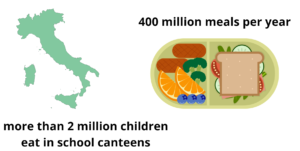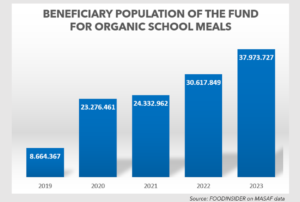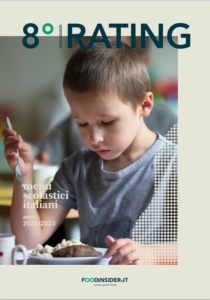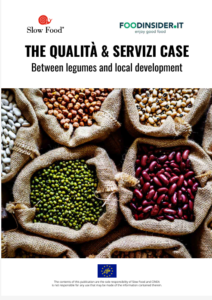https://www.youtube.com/shorts/RutFSrJC4-UFOODINSIER IDENTITY
 Foodinsider is an NGO dedicated to improving the quality of school canteens, making them tastier, healthier, and more environmentally sustainable. Our mission is to raise awareness on the crucial role school canteens play in the public school system and in the local economy as catalysts for positive change.
Foodinsider is an NGO dedicated to improving the quality of school canteens, making them tastier, healthier, and more environmentally sustainable. Our mission is to raise awareness on the crucial role school canteens play in the public school system and in the local economy as catalysts for positive change.
Foodinsider operates as an observatory, conducting annual assessments of menu quality and balance, and meticulously tracking their evolution over time. The findings from these evaluations are collected into an annual report, (English report) which serves as a summary of a more comprehensive analytical document. The report ranks the best menus, rewarding municipalities that promote healthy eating and achieve top rankings. It also highlights the variability in menu quality, with some menus falling at the bottom of the rankings. Every year we organize the School Canteen Summit in Rome where we reward the best school canteens in Italy and some organizations supporting the development of high-quality school canteen services connected to the local economy.
Foodinsider has a series of ongoing projects that help municipalities transition towards a more collaborative process to improve school canteen services, involving all stakeholders (parents, teachers, chefs, councelors, farmers). Sostenibilmense is the name of the main project that involves 14 municipalities in Tuscany and includes a chef competition called Sostenibilmense Award.
Among the activities of Foodinsider at a national level there is the Green Food Week, in February, that encourages all canteens to offer sustainable meals featuring legumes, vegetables, organic and local products. The event includes educational activities and a gastronomic competition.
SCHOOL CANTEENS IN ITALY
 In Italy, the school canteen service operates during school hours, supporting educational goals by promoting healthy eating and encouraging social interaction through communal meal. The meal consists of a first course, followed by a second course featuring a main protein source and a vegetable side dish. The meal typically ends with fruit.
In Italy, the school canteen service operates during school hours, supporting educational goals by promoting healthy eating and encouraging social interaction through communal meal. The meal consists of a first course, followed by a second course featuring a main protein source and a vegetable side dish. The meal typically ends with fruit.
The school canteen is managed by the municipality, which often (but not always) outsources the service to collective catering companies through a tender process. The fee that parents pay for the school cafeteria represents a contribution from the user to the overall cost borne by the municipality for the provision of the service. The average fee paid by parents for a daily meal falls within the range of 4 to 6 euros. Each municipality has its own standard rate. Families with low income can receive the canteen service for free or at a reduced cost.
In Italy, the responsibility for the school canteen service is distributed among different ministries. The Ministry of Health sets nutritional guidelines for school catering, defining the meal standards. The canteen service tenders must now take into account the European Green Public Procurement (GPP) guidelines, which have been enforced in Italy through the Minimum Environmental Criteria Law (CAM). These criteria were established by the Ministry of Environment, Land and Sea Protection through a decree dated March 10, 2020. The CAM law governs the procurement processes for managing school canteen services across municipalities.
Additionally, in 2017, the Ministry of Agricultural, Food and Forestry Policies (Mipaaf) introduced a fund to support municipalities that offer high percentages of organic food in school meals. This fund aims to lower the costs of organic meals, promote educational initiatives within schools, and support meal services. The Ministry of Education supports food education in schools, although its efforts is not yet systematic.
THE METHOD OF ANALYSIS
 The investigation on school menus spans several months and is divided into multiple steps: menu collection, data recording, data analysis, comparison with previous years’ data, data verification and consolidation and generation of the final report. Statistical processing and data analysis are presented in Chapter 3 of the report: “Results of the Investigation”.
The investigation on school menus spans several months and is divided into multiple steps: menu collection, data recording, data analysis, comparison with previous years’ data, data verification and consolidation and generation of the final report. Statistical processing and data analysis are presented in Chapter 3 of the report: “Results of the Investigation”.
In the initial phase, quantitative data are collected to assess the adherence of school menus to both health recommendations and to certain environmental sustainability criteria related to CAM. Data are collected by replying to the ‘points-based menu’ questionnaire. A score is assigned to each answer (for example: ‘How many varieties of cereals are on the menu?’ or ‘How often is meat offered?’ or ‘How many foods are organic?’ or ‘How many foods are local?’). Subsequently, by contacting the municipalities under investigation, additional quantitative and qualitative data are collected. In the 2024 survey the focus is on the quality of bread and oil. Over the years, the dialogue with the administrations has fostered continuous exchange and has led, with the most cooperative municipalities, to the creation of a genuine platform for interaction and discussion.
To complete the picture and provide answers that cannot be obtained through the questionnaire (such as the appeal of the offered dishes, and the correspondence between what is indicated on the menu and what is actually present in the dishes), a specific survey has been conducted to investigate parents’ and teachers’ perception of service quality. The main issue that emerges from the teachers’ replies is that a high percentage of food remains uneaten and becomes waste.
THE ANALYSED PANEL
Over the years, the sample size of the survey has grown to currently include 60 winter menus from primary school catering in Italy, which represent approximately 30% of the meals served in elementary schools. In 2023, the analysed panel consisted of 26 municipalities in the North, 24 in the Central regions, and 9 in the South of Italy, considering that school meal services are much less widespread in the southern regions.
THE CONCLUSION OF THE LAST FOODINSIDER SURVEY (2023)
 Foodinsider’s investigation demonstrates that the school canteen service can serve as a tool to enhance health, protect the environment, and promote the local economy.
Foodinsider’s investigation demonstrates that the school canteen service can serve as a tool to enhance health, protect the environment, and promote the local economy.
With the introduction of the Minimum Environmental Criteria (CAM), the Observatory has noted an improvement trend that began in 2022 after a pause due to the Covid-19 pandemic. The CAM effect is noticeable in menus that progressively adhere to a series of sustainability requirements: more local products, low-impact environmental foods (such as legumes), increased variety in cereal and vegetable offerings, more organic options, better quality of fish, and, in some cases, locally fished. Conversely, the gap between high-quality menus and mediocre ones is widening. On one hand, what contributes to this disparity is that some cafeterias have been competing for contracts in the past two years, implementing the new law (CAM) and improving their service and menus, while others have not yet had to renew their contracts. On the other hand, this gap also reflects the difference between two distinct visions of the role of the school catering service: the cafeteria that nourishes (both children and the community) and the cafeteria that merely satiates.
CHANGE IS POSSIBLE: THE BEST PRACTICE
 Every year, in partnership with Slow Food, we study a school canteen best practice in Italy or Abroad. One of these studies analyzed the evolution of a public company, called Qualità & Servizi, providing school catering services in the province of Florence. In 2015, the Municipality of Sesto Fiorentino, supplied by Qualità & Servizi, ranked poorly on Foodinsider due to its predominant use of processed food. However, it is now in our Top 10, thanks to a transformation process that rigorously implemented the objectives of the Minimum Environmental Criteria (CAM).
Every year, in partnership with Slow Food, we study a school canteen best practice in Italy or Abroad. One of these studies analyzed the evolution of a public company, called Qualità & Servizi, providing school catering services in the province of Florence. In 2015, the Municipality of Sesto Fiorentino, supplied by Qualità & Servizi, ranked poorly on Foodinsider due to its predominant use of processed food. However, it is now in our Top 10, thanks to a transformation process that rigorously implemented the objectives of the Minimum Environmental Criteria (CAM).
You can read the study available also in English.

